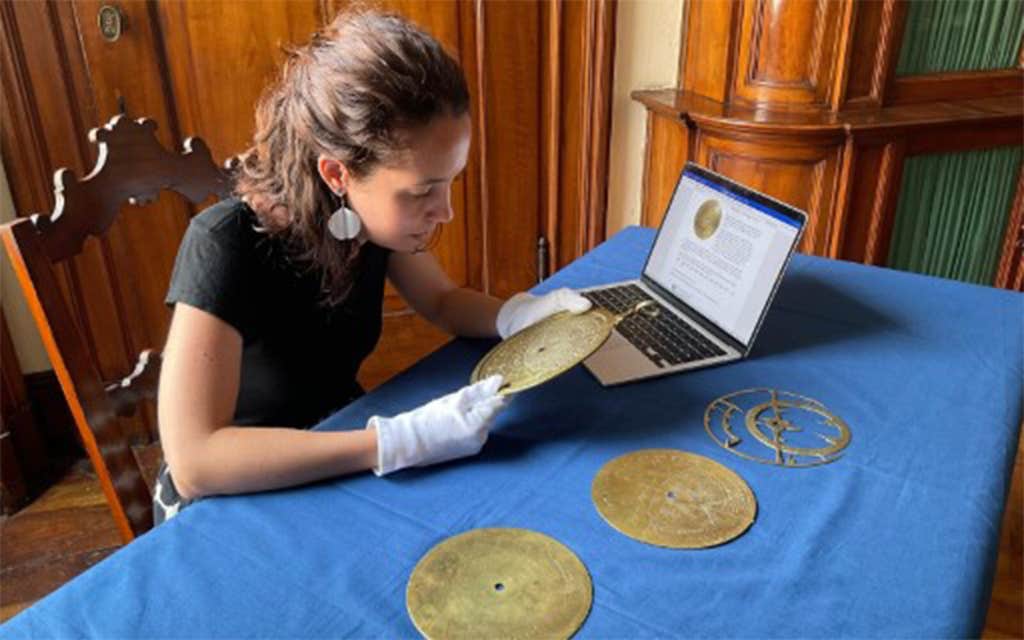Federica Gigante says an accident of lighting helped her to uncover the surprising history of an ancient astronomical device called an astrolabe, which some have described as the original smartphone.
When Gigante, an art historian and specialist in Islamic scientific instruments at the University of Cambridge, took the instrument out of its case to examine it, sunlight streaming through a nearby window caught some markings on one side. Later she determined these were words written by different hands in Hebrew, as well as Latin-style numbers. The original engravings on the instrument—already clear—were in Arabic, she says.
“That actually proved fundamental to the entire story because this very strong source of lighting from the side revealed scratches that you would not notice if you looked at the object in its case,” she says.
Gigante had traveled all the way to the northern Italian city of Verona from Cambridge to take a closer look at the astrolabe—which, like today’s smartphones, were portable devices used in the Middle Ages for timekeeping, date keeping, and wayfinding. They typically measured 3 to 18 inches and provided representations of the heavens that could identify the locations of stars, planets, and the moon. Gigante had noticed this particular astrolabe online a few months earlier when hunting for something else.
Astrolabes were portable devices used in the Middle Ages for timekeeping, date keeping, and wayfinding.
Together, the many layers of markings she found suggest the ornate brass instrument, held at the Fondazione Museo Miniscalchi-Erizzoa, was probably crafted in the city of Toledo, Spain in the 11th century, and likely changed hands at least six times between Islamic, Christian, and Jewish owners. In the 11th century, Toledo was a thriving multi-cultural center, mixing people from all three faiths.
“That’s the really interesting side of this,” says Gigante. “This type of astronomical knowledge was shared between different populations in a way that many people don’t realize today.” Gigante recently published her findings on the Verona astrolabe—which translates as “star taker” in Greek—in the historical journal Nuncius.
Astrolabes may have been invented by the ancient Greeks, as they appear in Greek writings from the fourth century B.C. But they seem to have entered European science in the early Middle Ages through Muslim astronomers, who greatly refined their uses. One Arabic astronomer wrote in the 10th century that astrolabes had more than 1,000 applications, including determining the qibla—the correct direction of Mecca for Muslim prayers—as well as surveying, timekeeping, and determining the latitude of a particular place.
Astrolabes ultimately proved impractical for use on ships, so they were superseded in the 15th century by “mariner’s astrolabes” and then in the 16th century by quadrants, and in the 18th century by sextants.
One side of the astrolabe Gigante examined carries a mark beside an inscription in Arabic “for the latitude of Cordoba, 38⁰ 30’” while the other side has a mark “for the latitude of Toledo, 40⁰.” The instrument seems originally to have been designed to determine the correct times for Muslim daily prayers at those locations. But it could have also been used to determine dates in the lunar calendar used by the Islamic religion, and such an expensive instrument might have been the property of an influential mosque, Gigante says.
Sometime later, it was marked with Arabic letters that read “”for Isḥāq […]/the work of Yūnus.” These are Jewish names—in English they translate to Isaac and Jonah—and may signify the instrument had been acquired by a new owner in Spain’s Sephardic community, where Arabic was the spoken language, Gigante says. Another plate made for the astrolabe at some later date is inscribed with latitudes that correspond to North Africa, suggesting that a new set of owners may have used it in Morocco or Egypt.

The astrolabe also bears inscriptions in Hebrew in two different hands—one of them made deep and neat marks, while the others were light and uneven. These Hebrew markings indicate it may have circulated still later among Jewish people in Italy, where Arabic was not understood, she says.
The Hebrew inscriptions and numerals scratched in Latin characters suggest the instrument was being recalibrated for a different place at a different time—possibly because the “procession of the equinoxes,” whereby the stars slowly change their annual positions over centuries, had rendered it out-of-date.
Certain mechanical adjustments Gigante identified in the Verona astrolabe— specifically, hammering the ends of its pointers slightly to the left—may have also constituted attempts to correct for changes in the positions of the stars.
The adjustments match the recommendations of the Spanish-Jewish polymath Abraham Ibn Ezra (1089-1167), who wrote a Hebrew treatise on the uses of an astrolabe during a visit to Verona. It called for an instrument to be checked before use to verify its accuracy.
Ultimately the astrolabe was acquired from the Jewish community in Verona by a 17th-century nobleman, who passed it onto a family that founded the museum where it was discovered. The object was almost overlooked before, but it is now one of their most treasured objects, Gigante says.
“This object is Islamic, Jewish, and European,” she says. “They can’t be separated.” ![]()
Lead photo by Federica Gigante
































